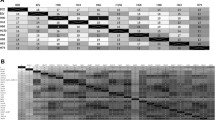Abstract
The objective of this study was to determine if human genotypes of Giardia lamblia could be found in canine companion animals from urban and peri-urban environments in Tucson, Arizona. Canine fecal samples collected from the Humane Society of Southern Arizona between July 2006 and April 2009 were screened for G. lamblia infection using immunofluorescent microscopy and confirmed by polymerase chain reaction (PCR). Of the 672 samples screened, 196 were found positive by IFA and 185 of those positive were successfully amplified through PCR. Sequencing analysis showed samples were primarily of the C or D genotypes (n = 154), or showing a mix of the C and D genotypes (n = 10). One sample showed a mixed infection of a human genotype (A) and a dog-specific genotype (C). These data are consistent with previous studies showing dog specific genotypes to be dominant in environments where dog-to-dog transmission is likely to occur, and provides further evidence that multiple genes should be targeted for more accurate genotype characterization.
Similar content being viewed by others
References
Amorós I, Alonso JL, Cuesta G (2010) Cryptosporidium oocysts and Giardia cysts on salad products irrigated with contaminated water. J Food Prot 73:1138–1140
Ballweber LR, Xiao L, Bowman DD, Kahn G, Cama V (2010) Giardiasis in dogs and cats: update on epidemiology and public health significance. Trends Parasitol 26:180–189
Baruch AC, Isaac-Renton J, Adam RD (1996) The molecular epidemiology of Giardia lamblia: a sequence-based approach. J Infect Dis 174:233–236
Beck R, Sprong H, Pozio H, Cacciò S (2012) Genotyping Giardia duodenalis isolates from dogs: lessons from a multilocus sequence typing study. Vector Borne Zoonotic Dis 12:206–213
Cacciò SM, Ryan U (2008) Molecular epidemiology of giardiasis. Mol Biochem Parasitol 160:75–80
Cacciò SM, de Giacomo M, Pozio E (2002) Sequence analysis of the β-giardin gene and development of PCR-RFLP assay to genotype Giardia duodenalis cysts from human faecal samples. Int J Parasitol 32:1023–1030
Claerebout E, Casaert S, Dalemans AC, De Wilde N, Levecke B, Vercruysse B, Geurden T (2009) Giardia and other intestinal parasites in different dog populations in Northern Belgium. Vet Parasitol 161:41–46
Cooper MA, Sterling CR, Gilman RH, Cama V, Ortega Y, Adam RD (2010) Molecular analysis of household transmission of Giardia lamblia in a region of high endemicity in Peru. J Infect Dis 202:1713–1721
Corpet F (1988) Multiple sequence alignment with hierarchical clustering. Nucleic Acids Res 16:10881–10890
Covacin C, Aucoin DP, Elliot A, Thompson RC (2011) Genotypic characterization of Giardia from domestic dogs in the USA. Vet Parasitol 177:28–32
Dado D, Montoya A, Blanco MA, Miró M, Saugar JM, Bailo B, Fuentes I (2012) Prevalence and genotypes of Giardia duodenalis from dogs in Spain: possible zoonotic transmission and public health importance. Parasitol Res 111:2419–2422
Feng Y, Xiao L (2011) Zoonotic potential and molecular epidemiology of Giardia species and giardiasis. Clin Microbiol Rev 24:110–140
Hopkins RM, Meloni BP, Groth DM, Wetherall JD, Reynoldson JA, Thompson RCA (1997) Ribosomal RNA sequencing reveals differences between the genotypes of Giardia isolates recovered from humans and dogs living in the same locality. J Parasitol 83:44–51
Itagaki T, Kinoshita S, Aoki M, Itoh N, Saeki H, Sato N, Uetsuki J, Izumiyama S, Yagita K, Endo T (2005) Genotyping of Giardia intestinalis from domestic and wild animals in Japan using glutamate dehydrogenase gene sequencing. Vet Parasitol 133:283–287
Lalle M, Jimenez-Cardosa E, Cacciò SM, Pozio E (2005a) Genotyping of Giardia duodenalis from humans and dogs from Mexico using a β-giardin nested polymerase chain reaction assay. J Parasitol 91:203–205
Lalle M, Pozio E, Capelli G, Bruschi F, Crotti D, Cacciò SM (2005b) Genetic heterogeneity at the β-giardin locus among human and animal isolates of Giardia duodenalis and identification of potentially zoonotic subgenotypes. Int J Parasitol 35:207–213
Leonhard S, Pfister K, Beelitz P, Wielinga C, Thompson RCA (2007) The molecular characterization of Giardia from dogs in southern Germany. Vet Parasitol 150:33–38
Monis PT, Thompson RCA (2003) Cryptosporidium and Giardia-zoonoses: fact or fiction? Infect Genet Evol 4:233–244
Read C, Walters J, Robertson ID, Thompson RCA (2002) Correlation between genotypes of Giardia duodenalis and diarrhoea. Int J Parasitol 32:229–231
Ritchie LS (1948) An ether sedimentation technique for routine stool examinations. Bull U S Army Med Dept 8:326
Silva FM P e, Monobe MM, Lopes FS, Araujo JP Jr (2012) Molecular characterization of Giardia duodenalis in dogs from Brazil. Parasitol Res 110:325–334
Sulaiman IM, Fayer R, Bern C, Gilman RH, Trout JM, Schantz PM, Das P, Lai AA, Xiao L (2003) Triosephosphate isomerase gene characterization and potential zoonotic transmission of Giardia duodenalis. Emerg Infect Dis 9:1444–1452
Thompson RCA (2004) The zoonotic significance and molecular epidemiology of Giardia and giardiasis. Vet Parasitol 126:15–35
Volotão AC, Costa-Macedo LM, Haddad FSM, Brandão A, Peralta JM, Fernandes O (2007) Acta Trop 102:10–19
Yoder JS, Gargano JW, Wallace RM (2012) Giardiasis Surveillance – United States, 2009–2010. MMWR 61:13–23
Yong TS, Park SJ, Hwang UW, Yang HW, Lee KW, Min DY, Rim HJ, Wang Y, Zheng F (2000) J Parasitol 86:887–891
Acknowledgments
We thank Andrew Clark and Debbie Schaefer for all their assistance and helpful discussions.
This project was funded by ARZT-136033-H-02-138, Enhanced detection of G. lamblia using PCR awarded to CRS.
Author information
Authors and Affiliations
Corresponding author
Rights and permissions
About this article
Cite this article
Johansen, K.M., Castro, N.S., Lancaster, K.E. et al. Characterization of Giardia lamblia genotypes in dogs from Tucson, Arizona using SSU-rRNA and β-giardin sequences. Parasitol Res 113, 387–390 (2014). https://doi.org/10.1007/s00436-013-3666-y
Received:
Accepted:
Published:
Issue Date:
DOI: https://doi.org/10.1007/s00436-013-3666-y



